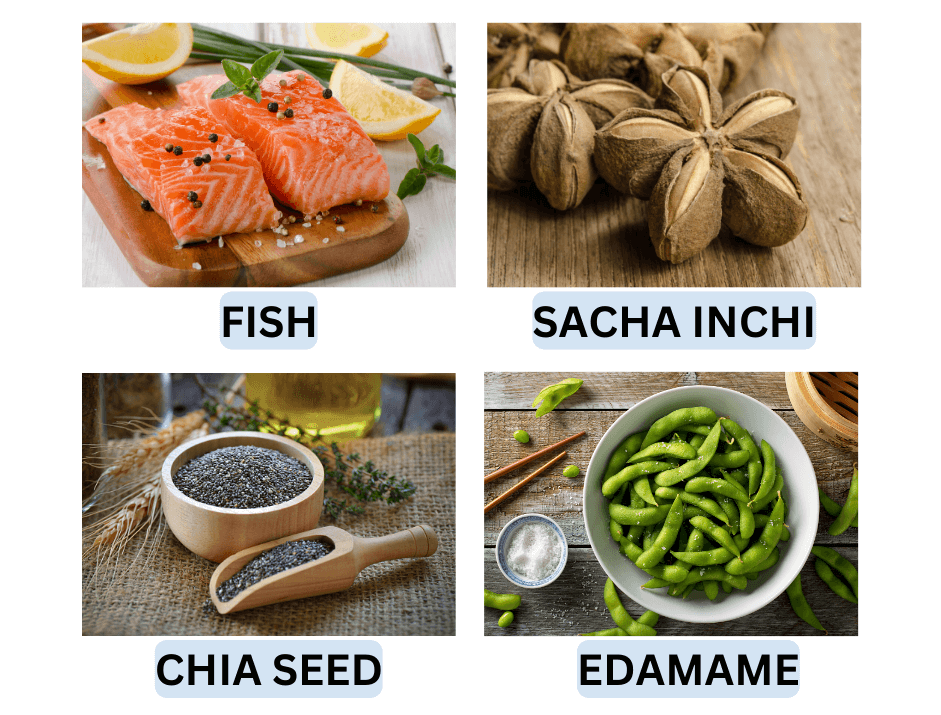Naturally occurring fats are composed of three types: saturated, monounsaturated, and polyunsaturated. The food industry created the fourth type, trans fat by hydrogenating polyunsaturated fats. Polyunsaturated fats (PUFA) can be classified into 2 groups which are omega-3 & omega-6 fatty acids.

What is Omega-3?
Omega-3 fatty acids are an integral part of cell membranes, helping to provide structure and support cell interaction. They are found in marine sources as EPA and DHA and some leafy vegetables, nuts, and oils as ALA.
| Tissues Distribution in Mammals | Dietary Sources | |
| α-linolenic acid (ALA) | Minor component of tissues | Some vegetable oils (sacha inchi, soy, canola, linseed) and leafy vegetables |
| Eicosapentaenoic acid (EPA) | Minor component of tissues | Fish and shellfish |
| Docosahexaenoic acid (DHA) | Major component of membrane phospholipids in retinal photoreceptors, cerebral grey matter, testes, and sperm | Fish and shellfish |
Table 1. Dietary Sources and Tissue Distribution of the Major Omega-3 Polyunsaturated Fatty Acids
The human body can synthesize most types of fats except for linoleic acid (omega-6) and α-linolenic acid (ALA). Due to that, they are dubbed as ‘essential acids’ and must be obtained from food. ALA can be converted to EPA and DHA. It uses the same enzyme that converts omega-6, LA to arachidonic acid (AA), making them competitive.
NHANES III, the largest database of nutrient consumption of Americans, reported that the main PUFA in Western diets is LA (omega-6). It is typically consumed in 5-20-fold greater amounts than ALA. Omega-6 can promote inflammation when taken excessively. Therefore, a dietary shift towards fewer omega-3s and more omega-6s may significantly impact one’s health.
Health Effects of Omega-3
Omega-3 fatty acids have gained tremendous nutritional interest due to their reported antithrombotic and cardioprotective benefits. Increased intake of marine omega-3 fatty acids is known to provide beneficial effects on several cardiovascular risk factors. These includes:
- Blood pressure
- Platelet reactivity and thrombosis
- Concentrations of plasma triglyceride
- Vascular function
- Heart rate variability
- Inflammation.
This would act to slow or limit the buildup of fatty material within the blood vessel wall (atherosclerosis). According to some studies, omega-3 fatty acids have also shown some positive effects on rheumatoid arthritis and inflammatory bowel diseases.
Meanwhile, DHA, an essential structural component in the eye and brain has a vital role in optimizing visual and neurological development. DHA in particular may help in preventing neurodegenerative disease of aging.
On the other hand, plant-based omega-3, ALA is popular for preventing and treating diseases of the heart and blood vessels. It is said to be able to reverse atherosclerosis and lowers high blood pressure. They exert significant anti-inflammatory effects and help to improve blood lipid profile and endothelial function. ALA may serve as a suitable alternative for those who are concerned with the unsustainability of marine sources or those who practice vegetarianism.

Recommendations for the Intake of Omega-3
Given the wide-ranging importance and benefits of omega-3, it is imperative to include them in everyday diet. Food and Agriculture Organisation of the United Nations (FAO) and the European Food Safety Authority (EFSA) recommended the intake of omega-3 as such:
- Adult male: Min 250 mg/ EPA + DHA daily
- Non-pregnant/ non-lactating female: Min 250 mg/ EPA + DHA daily
- Pregnant/ lactating female: Min 300 mg EPA + DHA daily (200 mg from DHA)
Meanwhile, the Adequate Intake for ALA set by The Institute of Medicine is 1.6 g per day for men and 1.1 g per day for women. Eating one serving (200-400g) of oily fish approximately once or twice a week and a diet rich in ALA should be encouraged. The table below lists some foods that can add omega-3 to your diet.
| Type of foods (100 g/serving) | Omega-3 (g) |
| Mackerel (raw, Atlantic) | 2.5 |
| Salmon (farmed, Atlantic) | 2.5 |
| Herring (Pacific, raw) | 1.83 |
| Anchovy | 1.48 |
| Salmon (wild, Atlantic) | 1.73 |
| Flaxseed oil | 53.4 |
| Chia seeds | 17.8 |
| Sacha Inchi nuts | 11.2 |
| Walnut | 9.08 |
| Edamame | 0.36 |
Source: USDA Food Database
Different types of fish contain different amounts and ratios of EPA to DHA. Fish may be the best dietary source of omega-3s however, you can also gain this essential nutrient from some plant-based foods.
References
Calder, P. C. (2013). Nutritional benefits of omega-3 fatty acids. https://doi.org/10.1533/9780857098863.1.3.
DeFilippis, A. P. & Sperling, L. S. (2005). Understanding omega-3’s. American Heart Journal. 151(3), 564 – 570. doi: 10.1016/j.ahj.2005.03.051.
Gropper, S. S. & Smith, J. L. (2013). Advanced nutrition and human metabolism (6th ed.). Yolanda Cossio, Wadsworth Cengage Learning.
U.S. Department of Agriculture, Agricultural Research Service. FoodData Central, 2019. fdc.nal.usda.gov.
